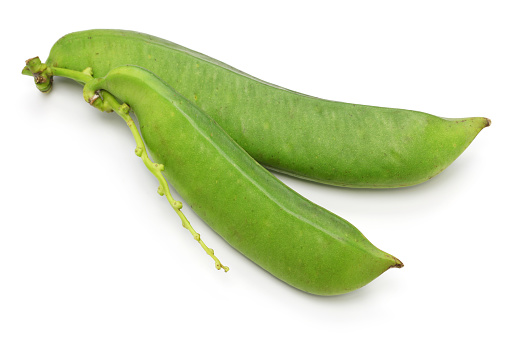

Canavalia gladiata (Jacq.) DC.
|
It is commonly known as Badi sem and belongs to the Fabaceae family. Unripe pods and seeds are consumed as vegetable in cooked form. Concanavalin A, Canavanine, 4-O-methylgallic acid, and Gallotannin are some of the bioactives reported from this plant. CAEC (Canavalia gladiata Arctium lappa extract complex) enhanced immune function by stimulating NK cell activity through IL-10 expression in adult human (25-75 years old) with a WBC count ranging from 3000 to 8000 cells/µL after 8 weeks of randomised, double-blind, placebo-controlled clinical trial. Hence, the results anticipated that CAEC can be developed as a functional food for stimulating immunity. Mode of Consumption : Fried and cooked |
| Plant Details | Agro-climatic Zone | Vernacular Names | Pictures |
| Scientific Name: Canavalia gladiata (Jacq.) DC. Family: Fabaceae Lindl. Class: Magnoliopsida Order: Fabales Genus: Canavalia DC. Fruiting Season: April to June Parts: Pod and seed |
|
Andhra Pradesh : Yeratamma Bihar : Bara sem, Lal kadsumbal Haryana : Bara sem, Lal kadsumbal Jharkhand : Bara sem, Lal kadsumbal Karnataka : Shembi avare, Tumbekai Madhya Pradesh : Bara sem, Lal kadsumbal Maharashtra : Abai Manipur : Tebi Rajasthan : Bara sem, Lal kadsumbal Tamil Nadu : Segaputhambattai Uttar Pradesh : Bara sem, Lal kadsumbal Uttarakhand : Bara sem, Lal kadsumbal West Bengal : Makhan shim |
 Pods |
| Compound/Extract | Activity | Mode of Action | Marker/References |
| Fermented C. gladiata extract | Anti-inflammatory | Extracts of fermented C. gladiata (FCG) improved immune responses in NC/Nga mice (Atopic dermatitis control), including increased levels of IgE and histamine for AD (Atopic control) through attenuation of Th1/Th2 cytokine imbalance, and production of proinflammatory cytokines and chemokines. | IgE[1] |
| Canavalia gladiata and Arctium lappa extract complex | Immunostimulatory | CAEC (Canavalia gladiata and Arctium lappa extract complex) enhanced immune function by stimulating NK cell activity through IL-10 expression in adult human (25-75 years old) with a WBC count ranging from 3000 to 8000 cells/µL after 8 weeks of randomised, double-blind, placebo-controlled clinical trial. Hence, the results anticipated that CAEC can be developed as a functional food for stimulating immunity. | IL-10[2] |
| Purified lectin | Immunomodulatory | Lectin isolated from Canavalia gladiata shows mitogenic activity for mouse splenic cells and significantly strong antiproliferative activity for B16 melanomacells as well as enhances the activity of splenic natural killer (NK) cells against YAC-1 cells. Canavalia gladiata shows an immunomodulatory effect associated with the activation of NK cells and splenic cells. | [3] |
| Beans | Anti-inflammatory | Sword beans attenuates NO, IL-6 and TNF-α production in the LPS-stimulated RAW264.7 cells in the dose dependent manner. | NO, IL-6 and TNF-α[4] |
| Major Class | Metabolites (Content of bioactives: mg/100g Fresh Weight) |
| 4-O-methylgallic acid: , Canavanine: , Concanavalin A: , Tetragalloyl hexoside: [4] | |
| Alcohol | 4-Heptanol,3-methyl : [5] |
| Alkane | Heptane,2,6-dimethyl: , Hexadecane : , Nonadecane: , Tridecane : [5] |
| Alkene | 1-Docosene: , 1-Dodecene: , 1-Hexadecene: , 1-Nonadecene: , 1-Tetradecene: [5] |
| Aromatic Hydro-carbon | Benzene (1,3,3-Trimethylnonyl): , Benzene 1,3,5 Trimethyl: , Benzene1,2,3-trimethyl: [5] |
| Carboxylic acid | Oxalic acid,4-chlorophenyl tetradecyl ester: [5] |
| Ketone | 3-Hexanone,2,4-dimethyl: [5] |
| Phenol | Phenol,2,4-bis (1,1-dimethylethyl): [5] |
| Silicon ether | Silane,dimethyl [docosyloxy]butoxy: [5] |
| Sugar | 1,6-Anhydro-3,4-dideoxy-β-D-mannohexapyranose: [5] |
| Terpene | Bicyclo [2,1,1,]hexane-2-ol,2-ethenyl: [5] |
| Effect | Observation | DOI |
| Disease | Formulation | Reference | Author | TKDL |
| Nephritis | Khal-ma-zho-sha | Dud-tsi nying-po yan-lag gyad-pa sang-wa man-ngag gi-gyud zes-ja-wa (Four Tantras) - compiled by Youthok Yontan Gonbo - Published By - T. Sonam Tashigang B.P.O.- sNyimo Leh-Ladakh 1973 | Buddha Shakamuni | Sow Rigpa |
| Information from Wealth of India | Reference |
|
CSIR(1950).The Wealth of India, Raw materials,Vol.-II ,P.56-57, New Delhi, India |
| 4.2, 4.2.1, 4.2.1.1, 4.2.1.3, 4.2.2.8, 4.2, 4.2.1, 4.2.1.1, 4.2.1.3, 4.2.2.8 |
| CSIR-North East Institute of Science and Technology, Jorhat-6, Assam, India
CSIR-Institute of Himalayan Bioresource Technology, Palampur-61,Himachal Pradesh, India |